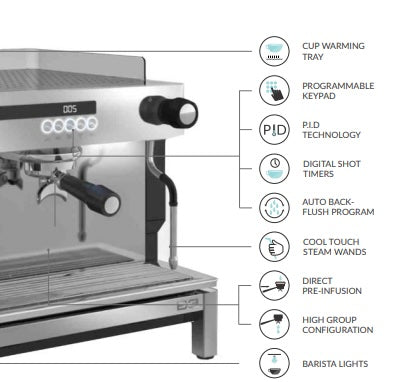
Know Thy Machinery: The Key to Consistent Coffee and a Healthier Bottom Line
If you’ve ever worked behind a commercial espresso machine, you’ll know the rhythm of a good barista shift is like a well-rehearsed band: tight timing, smooth transitions, and an end result that makes people smile. But that magic doesn’t just happen—it’s built on consistency, understanding, and a bit of know-how that only comes with time and intention.
In this post, we’re diving into what really makes a barista’s workflow sing. Whether you're just starting out or have years of milk-slinging under your belt, there’s always room to tighten the craft and get more from every gram of coffee.
The Brew Recipe: Your Compass in the Chaos
Let’s start with the brew recipe—the backbone of any consistent espresso bar. Think of it as your coffee compass. For sweet, well-rounded espresso, your starting point might look like:
- In: 20g of coffee
- Out: 60 grams of espresso
- Time: 28–34 seconds
This example ratio creates balance: not sour, not bitter. But it’s not just about numbers—consistency is king. Using scales throughout the day helps reduce under- or overdosing. It only takes a few grams off-course to throw your costs and your flavour out of whack.
Wasted Grinds = Wasted Dollars
Grind retention is a sneaky profit killer. A couple of fresh purges too many per shift can chew through a kilo quicker than you think. Be mindful of how often you’re purging or recalibrating, and work as a team to keep waste in check. Every gram matters: for example, a 20g dose gives you 50 serves per kilo. At $6.50 per milk-based 12oz, that’s $275 from one kilo—and when done consistently well, easily $325+ in the till.
Get to Know Your Gear (Seriously)
Too many baristas don’t know their machines or grinders beyond the basics. If you want to really up your game, take 15 minutes and read the manual.
Your Grinder: Where the Magic (or the Mess) Begins
Let’s be real—your espresso grinder is the unsung hero of the whole operation. You can have the fanciest machine, the prettiest cups, and the best beans money can buy… but if your grind is off, your coffee’s off.
Grind size controls how water flows through the puck, how evenly it extracts, and ultimately, whether your espresso tastes sweet, balanced and full-bodied—or sour, bitter, and hollow. In short: the grinder is the gatekeeper of flavour.
Control Your Grind, Control Your Coffee
When your grinder’s dialled in, you’re setting yourself up for consistency across every shot. But it’s not a “set and forget” situation. Grinder settings shift throughout the day due to heat, humidity, and bean freshness. What worked at 7:00 a.m. will probably need adjusting by 10:30.
A good barista knows to check in with the grinder often:
- Is your shot running too fast or slow?
- Does the crema look too thin or too dark?
- Is the flavour pulling short, sharp, or muddy?
These are all signs the grind needs a tweak. Fine grind = slower shot, more body. Coarse grind = faster shot, less complexity. Your job is to ride that balance and make micro-adjustments throughout the day to stay in the sweet spot.
Know Your Burrs
The burrs inside your grinder do the heavy lifting. Flat or conical, steel or titanium—they all wear down over time. Worn burrs mean inconsistent grind sizes, and that leads to uneven extraction. If you're not sure when your burrs were last changed, it’s time to check.
As a rule of thumb:
- For high-volume cafés, change burrs every 400–600kg of coffee.
- Clean them weekly (at least) with a dry grinder cleaner or manually if your café permits.
Treat Your Grinder Like a Tool, Not a Mystery Box
Too many baristas treat grinders like an appliance, not an instrument. If you’re in charge of the dial, then take ownership of it. Understand your grinder’s quirks—how much it retains, how it handles heat, what settings work for your bean and brew recipe. Learn how to dismantle it safely and clean it properly. This knowledge is power.
And honestly? If more baristas respected the grinder like they do the espresso machine, we’d all be drinking better coffee.
Mastering Your Espresso Machine: Don’t Just Push Buttons, Know What They Do
Let’s be honest—too many baristas hop on a machine and just press the same buttons every day without knowing what they actually do. Your espresso machine isn’t just a glorified kettle. It’s a precision instrument, and when you understand it fully, you take control of quality, consistency, and even speed.
One of the most underutilised features of modern commercial machines? Volumetric programming.
Volumetric Buttons = Built-In Consistency
Most commercial espresso machines have programmable volumetric buttons—usually marked as single shot, double shot, and sometimes custom options. These aren’t just for convenience. They let you pre-set how much water flows through the coffee puck for each button press.
Why does this matter?
Because volume = yield. And espresso flavour is all about that ratio between grams in (your dose) and millilitres out (your yield). If your double shot button is pumping 80ml out of a 20g dose, you're not brewing espresso—you’re brewing disappointment.
How to Set Volumetric Buttons (And Why You Should)
- Pull a shot manually using the continuous/manual button.
- Weigh your dose (e.g. 20g in).
- Watch the flow, time the shot, and stop at your desired yield (e.g. 60 grams out in 28–34 seconds).
- Once you’re happy, enter programming mode (usually by holding a specific button down for a few seconds—check your machine manual).
- Run the shot again and lock in the volume by stopping it at the same yield—this tells the machine “this is how much water you use for this button.”
- Repeat for the other buttons as needed.
Once done, every button press delivers consistent water volume—as long as your grind and tamp are consistent too.
Why It Matters
✔️ Saves time under pressure.
✔️ Prevents over-extraction or weak shots.
✔️ Keeps your brew recipe rock-solid, especially if multiple baristas share the machine.
✔️ Builds flavour consistency, which means happy customers who come back for more.
Regular TLC: Cleaning and Maintenance
Even the best espresso machine will betray you if it’s not properly maintained.
- Backflush every day with water, and with good quality cleaning powder, we recommend the Cafetto Brand. Made in Adelaide.
- Scrub your group head screens and seals.
- Clean steam wands thoroughly after every use.
- Check pressure gauges and boiler levels.
Machines that are looked after will pull better shots, last longer, and save your café thousands in repairs.
Final Thought: Know Your Tools, Respect the Craft
As a barista, your gear is an extension of your craft. Learn the quirks of your espresso machine. Understand your grinder. Take ownership of your brew recipe. The more you know, the smoother your workflow, the better your coffee, and the more trust you build with your customers.
And trust? That’s what fills the till.
Customer Service is a Brewed Experience
Yes, we’re baristas—but we’re also front-line reps for the café. Every interaction is a chance to build loyalty. A welcoming smile, remembering someone’s order, or simply making eye contact can make all the difference. Great customer service = repeat customers = more sales.
The Takeaway: Small Tweaks, Big Gains
- Lock in a consistent brew recipe and stick to it.
- Use your scales—dose accuracy protects flavour and profits.
- Keep wastage low—track fresh grind waste and purge habits.
- Deepen your equipment knowledge—read, watch, ask questions.
- Clean everything, often.
- Smile, engage, and know your regulars.
The truth is, making great coffee isn’t about flair. It’s about intention. Every shot, every latte, every hello across the bar is a reflection of your professionalism—and when you bring your A-game, the café wins.
Need help building your café’s brew guide or staff training checklist? I’ve spent years working with cafés to tighten their workflow and would be happy to share what I’ve learned.
Let’s make better coffee, together.
